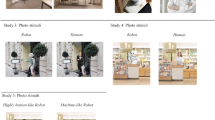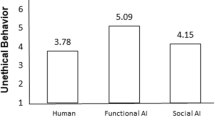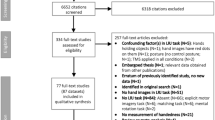Abstract
We examine whether non-human looking humanoid robot arms can be perceived as part of one’s own body. In two subsequent experiments, participants experienced high levels of embodiment of a robotic arm that had a blue end effector with no fingers (Experiment 1) and of a robotic arm that ended with a gripper (Experiment 2) when it was stroked synchronously with the real arm. Levels of embodiment were significantly higher than the corresponding asynchronous condition and similar to those reported for a human-looking arm. Additionally, we found that visuo-movement synchronization also induced embodiment of the robot arm and that embodiment was even partially maintained when the robot hand was covered with a blue plastic cover. We conclude that humans are able to experience a strong sense of embodiment towards non-human looking robot arms. The results have important implications for the domains related to robotic embodiment.



Similar content being viewed by others
References
Botvinick M, Cohen J (1998) Rubber hands “feel” touch that eyes see. Nature 391:756. doi:10.1038/35784
Tsakiris M, Haggard P (2005) The rubber hand illusion revisited: visuotactile integration and self-attribution. J Exp Psychol Hum Percept Perform 31:80–91. doi:10.1037/0096-1523.31.1.80
Hohwy J, Paton B (2010) Explaining away the body: experiences of supernaturally caused touch and touch on non-hand objects within the rubber hand illusion. PLoS ONE 5:e9416. doi:10.1371/journal.pone.0009416
Armel KC, Ramachandran VS (2003) Projecting sensations to external objects: evidence from skin conductance response. Proc Biol Sci 270:1499–506. doi:10.1098/rspb.2003.2364
Maselli A, Slater M (2013) The building blocks of the full body ownership illusion. Front Hum Neurosci 7:83. doi:10.3389/fnhum.2013.00083
Holmes NP, Snijders HJ, Spence C (2006) Reaching with alien limbs: visual exposure to prosthetic hands in a mirror biases proprioception without accompanying illusions of ownership. Percept Psychophys 68:685–701. doi:10.3758/BF03208768
Longo MR, Schüür F, Kammers MPM et al (2009) Self awareness and the body image. Acta Psychol (Amst) 132:166–172. doi:10.1016/j.actpsy.2009.02.003
Pavani F, Zampini M (2007) The role of hand size in the fake-hand illusion paradigm. Perception 36:1547–1554. doi:10.1068/p5853
Ehrsson HH, Spence C, Passingham RE (2004) That’s my hand! Activity in premotor cortex reflects feeling of ownership of a limb. Science 305:875–877. doi:10.1126/science.1097011
Costantini M, Haggard P (2007) The rubber hand illusion: sensitivity and reference frame for body ownership. Conscious Cogn 16:229–240. doi:10.1016/j.concog.2007.01.001
Lloyd DM (2007) Spatial limits on referred touch to an alien limb may reflect boundaries of visuo-tactile peripersonal space surrounding the hand. Brain Cogn 64:104–109. doi:10.1016/j.bandc.2006.09.013
Romano D, Caffa E, Hernandez-Arieta A et al (2015) The robot hand illusion: Inducing proprioceptive drift through visuo-motor congruency. Neuropsychologia 70:414–420. doi:10.1016/j.neuropsychologia.2014.10.033
Hellman RB, Chang E, Tanner J et al (2015) A robot hand testbed designed for enhancing embodiment and functional neurorehabilitation of body schema in subjects with upper limb impairment or loss. Front Hum Neurosci 9:1–10. doi:10.3389/fnhum.2015.00026
Alimardani M, Nishio S, Ishiguro H (2013) Humanlike robot hands controlled by brain activity arouse illusion of ownership in operators. Sci Rep 3:2396. doi:10.1038/srep02396
Aymerich-Franch L (2012) Can we identify with a block ? Identification with non-anthropomorphic avatars in virtual reality games. In: Proc. Int. Soc. Presence Res. Annu. Conf
Aymerich-Franch L (2010) Presence and emotions in playing a group game in a virtual environment: the influence of body participation. Cyberpsychol Behav Soc Netw 13:649–654. doi:10.1089/cyber.2009.0412
Aymerich-Franch L, Kizilcec RF, Bailenson JN (2014) The relationship between virtual self similarity and social anxiety. Front Hum Neurosci 8:1–10. doi:10.3389/fnhum.2014.00944
Aymerich-Franch L, Petit D, Ganesh G, Kheddar A (2015) Embodiment of a humanoid robot is preserved during partial and delayed control. In: 2015 IEEE Int. Work. Adv. Robot. its Soc. Impacts
Petit D, Gergondet P, Cherubini A, Kheddar A (2015) An integrated framework for humanoid embodiment with a BCI. In: IEEE Int. Conf. Robot. Autom
Kaneko K et al (2004) Humanoid robot HRP-2. In: IEEE Int. Conf. Robot. Autom
Mansard N, Stasse O, Evrard P, Kheddar A, (2009) A versatile generalized inverted kinematics implementation for collaborative working humanoid robots: the stack of tasks. In: 2009 Int. Conf. Adv. Robot
Kilteni K, Groten R, Slater M (2012) The sense of embodiment in virtual reality. Presence Teleoper Virtual Environ 21:373–387. doi:10.1162/PRES_a_00124
Longo MR, Schüür F, Kammers MPM et al (2008) What is embodiment? a psychometric approach. Cognition 107:978–998. doi:10.1016/j.cognition.2007.12.004
Blanke O, Metzinger T (2009) Full-body illusions and minimal phenomenal selfhood. Trends Cogn Sci 13:7–13. doi:10.1016/j.tics.2008.10.003
Sackett DL (1979) Bias in analytic research. J Chronic Dis 32:51–63. doi:10.1016/0021-9681(79)90012-2
Connor KM, Kobak KA, Churchill LE et al (2001) Mini-SPIN: a brief screening assessment for generalized social anxiety disorder. Depress Anxiety 14:137–140
Seeley-Wait E, Abbott MJ, Rapee RM (2009) Psychometric properties of the mini-social phobia inventory. Prim Care Companion J Clin Psychiatry 11:231–236. doi:10.4088/PCC.07m00576
Aymerich-Franch L, Petit D, Ganesh G, Kheddar A (2016) The second me: seeing the real body during humanoid robot embodiment produces an illusion of bi-location. Conscious Cogn 46:99–109. doi:10.1016/j.concog.2016.09.017
Sanchez-Vives MV, Spanlang B, Frisoli A et al (2010) Virtual hand illusion induced by visuomotor correlations. PLoS ONE 5:e10381. doi:10.1371/journal.pone.0010381
Aymerich-Franch L, Ganesh G (2015) The role of functionality in the body model for self-attribution. Neurosci Res. doi:10.1016/j.neures.2015.11.001
Ehrsson H (2012) The concept of body ownership and its relation to multisensory integration. In: Stein BE (ed) The new handb. multisensory process. Cambridge, MA: Mit Press, pp 775–792
MacKenzie IS (2013) Human–computer interaction: an empirical research perspective. Morgan Kaufmann, Waltham
Kantowitz BH, Roediger HL III, Elmes DG (2015) Experimental psychology. Cengage Learning, Stamford, CT, USA
Greenwald AG (1976) Within-subjects designs: to use or not to use? Psychol Bull 83:314–320. doi:10.1037/0033-2909.83.2.314
Aymerich-Franch L Mediated embodiment in new communication technologies. In: Khosrow-Pour M (ed) Encyclopedia of information science and technology, 4th edn. Hershey, IGI Global (in press)
Mori M (1970) The uncanny valley. Energy 7:33–35. doi:10.1162/pres.16.4.337
Ferrari F, Paladino MP, Jetten J (2016) Blurring human–machine distinctions: anthropomorphic appearance in social robots as a threat to human distinctiveness. Int J Soc Robot 1–16. doi:10.1007/s12369-016-0338-y
Złotowski J, Proudfoot D, Yogeeswaran K, Bartneck C (2014) Anthropomorphism: opportunities and challenges in human–robot interaction. Int J Soc Robot 7:347–360. doi:10.1007/s12369-014-0267-6
Acknowledgements
This project has received funding from the European Union with the Marie Curie IOF Fellowship project HumRobCooperation under Grant agreement No. PIOF-CT-622764. It is also partially supported from the FP7 IP VERE No. 257695 and the Kakenhi ‘houga’ Grant 15616710 from the Japan Society for the Promotion of Science (JSPS). We specially thank Prof. E. Yoshida for his support in the ethical procedures and the interns at our laboratory in Japan who collaborated for the pretest or to appear in the pictures.
Author information
Authors and Affiliations
Corresponding author
Electronic supplementary material
Below is the link to the electronic supplementary material.
Supplementary material 1 (mp4 23858 KB)
Appendices
Appendix 1
Embodiment questionnaire for Study 1
From 1 (not at all) to 7 (very strongly), how strongly do you feel as if...
The arm you see was part of your body
The arm you see was in the location of your real arm
You could push an object with the arm you see
Embodiment questionnaire for Study 2
From 1 (not at all) to 7 (very strongly), it seems like...
You are looking directly at your own arm, rather than at a rubber/robot arm
The rubber/robot arm is part of your body
The rubber/robot arm is your arm
The rubber/robot arm belongs to you
The rubber/robot arm begins to resemble your real arm
The rubber/robot arm is in the location where your arm is
Your arm is in the location where the rubber/robot arm is
You could push an object with the arm you see
You could move the arm you see
Questions for the brief interview in Study 2
-
1.
Describe a little bit the experience you just had.
-
2.
From all the conditions you experienced, in which one the illusion that the arm you saw through the visor was strongest?
-
3.
In general, was the sensation stronger in the synchronous or in the asynchronous conditions?
-
4.
Was the sensation of seeing a human or a robot arm different, which one created a stronger illusion that the arm became your arm?
-
5.
From all the (synch) robot arm conditions you experienced, in which one the illusion was stronger: the gripper or the arm with a blue cover? For the cover arm: the one in which we brushed your hand or the one in which you moved your hand and the robot hand moved?
-
6.
Is there any sensation or anything else that you experienced which we did not ask you during the experiment that you would like to share with us? (e.g. anything that prevented you from having a stronger experience, etc.)
Appendix 2
Experimental conditions in Experiment 1 and 2 (Table 3).
Appendix 3
Overall results for embodiment by condition in Experiment 1 and 2 (Table 4).
Rights and permissions
About this article
Cite this article
Aymerich-Franch, L., Petit, D., Ganesh, G. et al. Non-human Looking Robot Arms Induce Illusion of Embodiment. Int J of Soc Robotics 9, 479–490 (2017). https://doi.org/10.1007/s12369-017-0397-8
Accepted:
Published:
Issue Date:
DOI: https://doi.org/10.1007/s12369-017-0397-8




